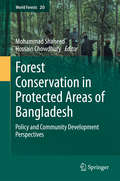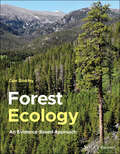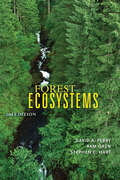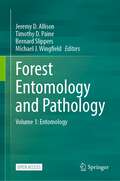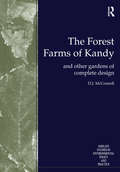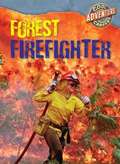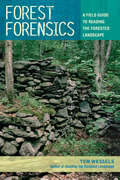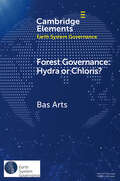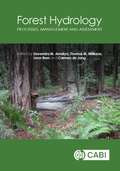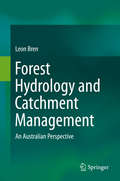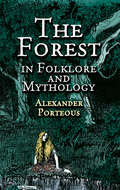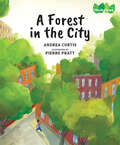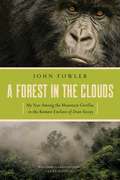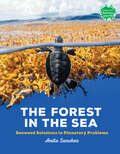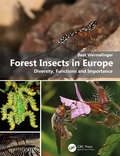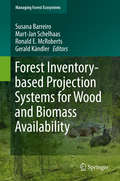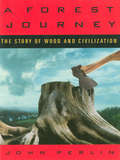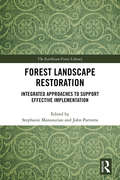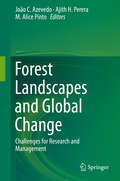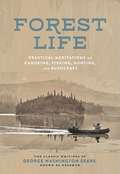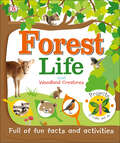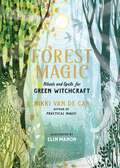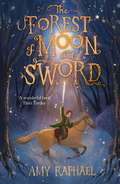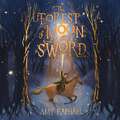- Table View
- List View
Forest conservation in protected areas of Bangladesh
by Mohammad Shaheed Hossain ChowdhuryThis book dealt with a number of issues under the broad subject matter of protected area focusing on the policy of collaborative management as a means to augment the forest conservation activities and enhance community development in Bangladesh. Studies covered in the book emerged with the success stories of protected area co-management, both in terms of community development and biodiversity conservation. Significant level of development was noticed in the socio-economic conditions of the surrounding communities. Empowerment and improved social dignity of women participants signifies the initiation of co-management approach. The principles of participatory governance were found reasonably well reflected in legal and policy frameworks. Based on the lessons from the studies, a general metaphysical model, namely 'Spider-web model of protected area co-management' has been developed that can be potentially applicable in countries where local communities rely heavily on protected areas.
Forest Ecology: An Evidence-Based Approach
by Dan BinkleyForest Ecology Forest Ecology An Evidence-Based Approach Forest ecology is the science that deals with everything in forests, including plants and animals (and their interactions), the features of the environment that affect plants and animals, and the interactions of humans and forests. All of these components of forests interact across scales of space and time. Some interactions are constrained, deterministic, and predictable; but most are indeterminant, contingent, and only broadly predictable. Forest Ecology: An Evidence-Based Approach examines the features common to all forests, and those unique cases that illustrate the importance of site-specific factors in determining the structure, function, and future of a forest. The author emphasizes the role of evidence in forest ecology, because appealing, simple stories often lead to misunderstandings about how forests work. A reliance on evidence is central to distinguishing between appealing stories and stories that actually fit real forests. The evidence-based approach emphasizes the importance of real-world, observable science in forests. Classical approaches to ecology in the twentieth century often over-emphasized appealing concepts that were not sufficiently based on real forests. The vast amount of information now available on forests allows a more complete coverage of forest ecology that relies on a strong, empirical foundation. Forest Ecology: An Evidence-Based Approach is the ideal companion text for the teaching of upper-level undergraduate and graduate courses in forest ecology.
Forest Ecosystems
by David A. Perry Ram Oren Stephen C. Hart2009 Outstanding Academic Title, ChoiceThis acclaimed textbook is the most comprehensive available in the field of forest ecology. Designed for advanced students of forest science, ecology, and environmental studies, it is also an essential reference for forest ecologists, foresters, and land managers. The authors provide an inclusive survey of boreal, temperate, and tropical forests with an emphasis on ecological concepts across scales that range from global to landscape to microscopic. Situating forests in the context of larger landscapes, they reveal the complex patterns and processes observed in tree-dominated habitats. The updated and expanded second edition covers • Conservation• Ecosystem services • Climate change• Vegetation classification• Disturbance• Species interactions• Self-thinning• Genetics• Soil influences• Productivity• Biogeochemical cycling• Mineralization• Effects of herbivory• Ecosystem stability
Forest Entomology and Pathology: Volume 1: Entomology
by Jeremy D. Allison Timothy D. Paine Bernard Slippers Michael J. WingfieldThis open access book will provide an introduction to forest entomology, the principles and techniques of forest insect pest management, the different forest insect guilds/feeding groups, and relevant forest insect pest management case studies. In addition to covering 30% of the earth, forest ecosystems provide numerous timber and non-timber products that affect our daily lives and recreational opportunities, habitat for diverse animal communities, watershed protection, play critical roles in the water cycle, and mitigate soil erosion and global warming. In addition to being the most abundant organisms in forest ecosystems, insects perform numerous functions in forests, many of which are beneficial and critical to forest health. Conversely, some insects damage and/or kill trees and reduce the capacity of forests to provide desired ecosystem services. The target audience of this book is upper-level undergraduate and graduate students and professionals interested in forest health and entomology.
The Forest Farms of Kandy: and Other Gardens of Complete Design (Routledge Studies in Environmental Policy and Practice)
by D.J. McConnell K.A.E. Dharmapala S.R. AttanayakeThroughout the tropical world, especially in South and Southeast Asia, tropical America, Africa and Oceania, there exists a range of forest garden farming systems. These are small, low-input, but productive and sustainable family units of highly diversified trees, palms, bushes and vines, with few conventional field crops or livestock. Providing a survey of these systems around the world and an in-depth analysis of the farms around Kandy, Sri Lanka, this book offers an economic and ecological description and evaluation of this ancient agroforestry system and its relationship to a wide range of global agro-development and environmental problems. Guided by a table that lists some 30 socio-economic and social criteria by which all farming systems can and should be evaluated, the book presents persuasive evidence supported by comprehensive references. It also examines historical and archaeological findings in order to assess the role these tropical forests played in the general adoption of agricultural farming.
Forest Firefighter (Cool Adventure Careers)
by William David ThomasThe first group of titles in an ongoing series introduces students to six amazing adventure careers. Geared for reluctant readers in upper elementary school and above, each high-interest title combines easy-to-follow text with engagin on-the-job photos to spark students' interest in reading and career exploration. Each book is filled with descriptive information about the career, along with the skills and requirements needed to pursue a job in the profiled field.
Forest Forensics: A Field Guide to Reading the Forested Landscape
by Tom WesselsTake some of the mystery out of a walk in the woods with this new field guide from the author of Reading the Forested Landscape. Thousands of readers have had their experience of being in a forest changed forever by reading Tom Wessels's Reading the Forested Landscape. Was this forest once farmland? Was it logged in the past? Was there ever a major catastrophe like a fire or a wind storm that brought trees down? Now Wessels takes that wonderful ability to discern much of the history of the forest from visual clues and boils it all down to a manageable field guide that you can take out to the woods and use to start playing forest detective yourself. Wessels has created a key—a fascinating series of either/or questions—to guide you through the process of analyzing what you see. You’ll feel like a woodland Sherlock Holmes. No walk in the woods will ever be the same.
Forest Governance: Hydra or Chloris? Forest Governance: Hydra or Chloris? (Elements in Earth System Governance)
by Bas ArtsMany forest-related problems are considered relevant today. One might think of deforestation, illegal logging and biodiversity loss. Yet, many governance initiatives have been initiated to work on their solutions. This Element takes stock of these issues and initiatives by analysing different forest governance modes, shifts and norms, and by studying five cases (forest sector governance, forest legality, forest certification, forest conservation, participatory forest management). Special focus is on performance: are the many forest governance initiatives able to change established practices of forest decline (Chloris worldview) or are they doomed to fail (Hydra worldview)? The answer will be both, depending on geographies and local conditions. The analyses are guided by discursive institutionalism and philosophical pragmatism. This title is also available as Open Access on Cambridge Core.
Forest Health: An Integrated Perspective
by John D. Castello Stephen A. TealeForest Health: An Integrated Perspective is the first book to define an ecologically rational, conceptual framework that unifies and integrates the many sub-disciplines that comprise the science of forest health and protection. This new global approach applies to boreal, temperate, tropical, natural, managed, even-aged, uneven-aged and urban forests, as well as plantations. Readers of the text can use real datasets to assess the sustainability of four forests around the world. Datasets for the case studies are at www.cambridge.org/9780521766692, and the text provides stepwise instructions for performing the calculations in Microsoft Excel. Readers can follow along as the editors perform the same calculations and interpret the results. Elevating forest health from a fuzzy concept to an ecologically sound paradigm, this is essential reading for undergraduate and graduate students and professionals interested in forest health, protection, entomology, pathology and ecology.
Forest Hydrology
by Devendra M. Amatya Thomas M. Williams Leon Bren Carmen JongForests cover approximately 26% of the world's land surface area and represent a distinct biotic community. They interact with water and soil in a variety of ways, providing canopy surfaces which trap precipitation and allow evaporation back into the atmosphere, thus regulating how much water reaches the forest floor as through fall, as well as pull water from the soil for transpiration. The discipline "forest hydrology" has been developed throughout the 20th century. During that time human intervention in natural landscapes has increased, and land use and management practices have intensified. This book: - Presents cutting edge thinking and assessments in forest hydrology across all latitudes and terrains, including state-of-the-art modelling techniques and methodologies - Describes the latest challenges facing forest hydrology, such as increased occurrence of disturbance, due to extreme floods, drought, disease, and fire, potentially caused by climate change - Is written by an internationally renowned team of scientists, engineers, and managers to give a well-rounded review of the subject The book will be useful for graduate students, professionals, land managers, practitioners, and researchers with a good understanding of the basic principles of hydrology and hydrologic processes.
Forest Hydrology and Catchment Management
by Leon BrenFor the last three centuries forests have been recognised as providing the best water catchments and valued for their sustained output of high quality water. In Australia, work which was commenced fifty years ago has come to fruition and is providing new information on forest hydrology issues. The book focusses on the issues of small streams, including catchment definition, slope, hydrograph formation, water quality measurement, and annual water yield. The world-wide management issues of sustaining riparian forests are examined, using the River Murray forests as an example. Finally a large amount of information is drawn together to examine the management of forested catchments for water supplies. This book presents an incisive, disciplined, quantitative approach to dealing with forest hydrology matters. Although world-wide in application, the book particularly draws on Australian studies. It is written with the needs of students and forest practitioners in mind.
The Forest in Folklore and Mythology
by Alexander PorteousAssembled from an enormous range of sources, this fascinating book is a mind-expanding compendium of facts, folklore, superstitions, myths, and anecdotes about trees and the forest. Included are descriptions of old forests; forest customs, temples and sacred groves; mythical forest creatures such as witches, fairies, demons, wood spirits, the "wild huntsman," and wood nymphs.The author also recounts facts and fables about individual trees, including famous trees throughout the world, unusual trees, tree worship, people's transformation into trees, and disposal of the dead in trees — as well as folklore about fossil trees, tree bark, leaves, thorns, diving rods, and Yule logs.This long-unavailable treasury of legend and lore will be welcomed by naturalists, anthropologists, students of folklore, and general readers alike.
A Forest in the City (ThinkCities #1)
by Andrea CurtisThis beautiful book of narrative non-fiction looks at the urban forest and dives into the question of how we can live in harmony with city trees. “Imagine a city draped in a blanket of green … Is this the city you know?” A Forest in the City looks at the urban forest, starting with a bird’s-eye view of the tree canopy, then swooping down to street level, digging deep into the ground, then moving up through a tree’s trunk, back into the leaves and branches. Trees make our cities more beautiful and provide shade but they also fight climate change and pollution, benefit our health and connections to one another, provide food and shelter for wildlife, and much more. Yet city trees face an abundance of problems, such as the abundance of concrete, poor soil and challenging light conditions. So how can we create a healthy environment for city trees? Urban foresters are trying to create better growing conditions, plant diverse species, and maintain trees as they age. These strategies, and more, reveal that the urban forest is a complex system—A Forest in the City shows readers we are a part of it. Includes a list of activities to help the urban forest and a glossary. The ThinkCities series is inspired by the urgency for new approaches to city life as a result of climate change, population growth and increased density. It highlights the challenges and risks cities face, but also offers hope for building resilience, sustainability and quality of life as young people act as advocates for themselves and their communities. Key Text Features diagrams author's note glossary sources definitions Correlates to the Common Core State Standards in English Language Arts: CCSS.ELA-LITERACY.RI.4.7 Interpret information presented visually, orally, or quantitatively (e.g., in charts, graphs, diagrams, time lines, animations, or interactive elements on Web pages) and explain how the information contributes to an understanding of the text in which it appears.
A Forest in the Clouds: My Year Among The Mountain Gorillas In The Remote Enclave Of Dr. Dian Fossey
by John FowlerFor the first time, a riveting insider's account of the fascinating world of Dr. Dian Fossey’s mountain gorilla camp, telling the often-shocking story of the unraveling of Fossey’s Rwandan facility alongside adventures tracking mountain gorillas over hostile terrain, confronting aggressive silverbacks, and rehabilitating orphaned baby gorillas. In A Forest in the Clouds, John Fowler takes us into the world of Karisoke Research Center, the remote mountain gorilla camp of Dr. Dian Fossey, a few years prior to her gruesome murder. Drawn to the adventure and promise of learning the science of studying mountain gorillas amid the beauty of Central Africa’s cloud forest, Fowler soon learns the cold harsh realities of life inside Fossey’s enclave ten thousand feet up in the Virunga Volcanoes. Instead of the intrepid scientist he had admired in the pages of National Geographic, Fowler finds a chain-smoking, hard-drinking woman bullying her staff into submission. While pressures mount from powers beyond Karisoke in an effort to extricate Fossey from her domain of thirteen years, she brings new students in to serve her most pressing need—to hang on to the remote research camp that has become her mountain home. Increasingly bizarre behavior has targeted Fossey for extrication by an ever-growing group of detractors—from conservation and research organizations to the Rwandan government. Amid the turmoil, Fowler must abandon his own research assignments to assuage the troubled Fossey as she orders him on illegal treks across the border into Zaire, over volcanoes, in search of missing gorillas, and to serve as surrogate parent to an orphaned baby ape in preparation for its traumatic re-introduction into a wild gorilla group. This riveting story is the only first-person account from inside Dian Fossey’s beleaguered camp. Fowler must come to grips with his own aspirations, career objectives, and disappointments as he develops the physical endurance to keep up with mountain gorillas over volcanic terrain in icy downpours above ten thousand feet, only to be affronted by the frightening charges of indignant giant silverbacks or to be treed by aggressive forest buffalos. Back in camp, he must nurture the sensitivity and patience needed for the demands of rehabilitating an orphaned baby gorilla. A Forest in the Clouds takes the armchair adventurer on a journey into an extraordinary world that now only exists in the memories of the very few who knew it.
The Forest in the Sea: Seaweed Solutions to Planetary Problems (Books for a Better Earth)
by Anita SanchezMeet an unlikely climate change hero: the wet, slimy stuff known as seaweed.Imagine forests where you can float weightlessly among schools of fish. Huge green pastures where sea turtles graze. Forests that capture carbon from seawater and breathe out oxygen. The answers to many of our planet&’s problems may lie underwater, in these forests of seaweed.Celebrated nonfiction author Anita Sanchez takes readers on a tour of seaweed forests, from the Sargasso Sea to seaweed patches off Prince Edward Island, to explore how seaweed supports marine ecosystems and plays a big role in climate change solutions. From reducing methane emissions to advances in biofuels, medicines, and more, seaweed science is at the forefront of innovation.Written with beauty and wonder, The Forest in the Sea encourages readers to think outside the box when it comes to climate change. Back matter includes recipes, activities, ways to identify and help protect seaweed, and more.Books for a Better Earth are designed to inspire children to become active, knowledgeable participants in caring for the planet they live on.Books for a Better Earth are designed to inspire children to become active, knowledgeable participants in caring for the planet they live on.A Junior Library Guild Gold Standard Selection
Forest Insects in Europe: Diversity, Functions and Importance
by Beat WermelingerForest insects play important roles ecologically and economically. They pollinate plants, decompose dead plant and animal tissue, provide food for vertebrates, regulate pest organisms and shape entire landscapes. Some are considered pests, while others provide usable products. Introduced species may become invasive, while the survival of others is threatened. Forest Insects in Europe: Diversity, Functions and Importance has been written not only with professional entomologists in mind, but also for nature lovers generally. The descriptions of the various roles insects play in forest ecosystems are intended to be easily comprehensible, but still scientific. The book is richly illustrated with attractive photos and contains 580 fascinating colour images of more than 300 different insect and spider species. The German edition was awarded the Prix Moulines by the Swiss Entomological Society in 2019.
Forest Inventory-based Projection Systems for Wood and Biomass Availability
by Susana Barreiro Mart-Jan Schelhaas Ronald E. Mcroberts Gerald KändlerThis book provides detailed descriptions of the forest biomass projection systems used in 22 countries in Europe and North America, as well as four European-wide systems. Separate chapters focus on the concepts of estimation of availability of woody biomass, compare and classify the different projection systems, and discuss the challenges and opportunities for the further development of these systems.
A Forest Journey: The Story of Wood and Civilization
by John PerlinA contemporary view of the effects of wood, as used for building and fuel, and of deforestation on the development of civilization. Until the ascendancy of fossil fuels, wood has been the principal fuel and building material from the dawn of civilization. Its abundance or scarcity greatly shaped, as A Forest Journey ably relates, the culture, demographics, economy, internal and external politics, and technology of successive societies over the millennia. The book's comprehensive coverage of the major role forests have played in human life--told with grace, fluency, imagination, and humor—gained it recognition as a Harvard Classic in Science and World History and as one of Harvard's "One-Hundred Great Books." Others receiving the honor include such luminaries as Stephen Jay Gould and E. O. Wilson. This new paperback edition will add a prologue and an epilogue to reflect the current situation in which forests have become imperative for humanity's survival.
Forest Landscape Restoration: Integrated Approaches to Support Effective Implementation (The Earthscan Forest Library)
by Stephanie Mansourian John ParrottaForest landscape restoration (FLR) is a planned process that aims to regain ecological integrity and enhance human wellbeing in deforested or degraded landscapes. The aim of this book is to explore options to better integrate the diverse dimensions - spatial, disciplinary, sectoral, and scientific - of implementing FLR. It demonstrates the value of an integrated and interdisciplinary approach to help implement FLR focusing specifically on four issues: understanding the drivers of forest loss and degradation in the context of interdisciplinary responses for FLR; learning from related integrated approaches; governance issues related to FLR as an integrated process; and the management, creation and use of different sources of knowledge in FLR implementation. The emphasis is on recognising the need to take human and institutional factors into consideration, as well as the more obvious biophysical factors. A key aim is to advance and accelerate the practice of FLR, given its importance, particularly in a world facing increasing environmental challenges, notably from climate change. The first section of the book presents the issue from an analytical and problem-orientated viewpoint, while later sections focus on solutions. It will interest researchers and professionals in forestry, ecology, geography, environmental governance and landscape studies.
Forest Landscapes and Global Change
by João C. Azevedo Ajith H. Perera M. Alice PintoClimate change, urban sprawl, abandonment of agriculture, intensification of forestry and agriculture, changes in energy generation and use, expansion of infrastructure networks, habitat destruction and degradation, and other drivers of change occur at increasing rates. They affect patterns and processes in forest landscapes, and modify ecosystem services derived from those ecosystems. Consequently, rapidly changing landscapes present many new challenges to scientists and managers. While it is not uncommon to encounter the terms "global change" and "landscape" together in the ecological literature, a global analyses of drivers of change in forest landscapes, and their ecological consequences have not been addressed adequately. That is the goal of this volume: an exploration of the state of knowledge of global changes in forested landscapes with emphasis on causes and effects, and challenges faced by researchers and land managers. Initial chapters identify and describe major agents of landscape change: climate, fire, and human activities. The next series of chapters address implications of changes on ecosystem services, biodiversity conservation and carbon flux. A chapter that describes methodologies of detecting and monitoring landscape changes is presented followed by chapter that highlights the many challenges forest landscape managers face amidst of global change. Finally, we present a summary and a synthesis of the main points presented in the book. Each chapter will contain the individual research experiences of chapter authors, augmented by review and synthesis of global scientific literature on relevant topics, as well as critical input from multiple peer reviewers.
Forest Life: Practical Meditations on Canoeing, Fishing, Hunting, and Bushcraft (Classic Outdoors)
by George Washington SearsForest bathers, readers of Cabin Porn and Your Cabin in the Woods, rejoice! This illustrated collection of Sears' odes to the outdoors is your perfect escape into nature. Forest Life collects George Washington Sears' timeless writing about the joys of exploring the wilderness, edited for a modern audience. In text both practical and inspirational, Sears' provides enduring wisdom about trips into the woods and lakes, including equipment, campfires, fishing, camp cooking, traveling light, and canoes.The original "forest bather," Sears wanted others to enjoy the woods as he did. His published Woodcraft in 1884 to help prepare skillful, self-reliant woodsman and to extol the restorative power of nature, writing "There are men who, on finding themselves alone in a pathless forest, become appalled, almost panic stricken. . . And there be some who plunge into an unbroken forest with a feeling of fresh, free, invigorating delight, as they might dash into a crisp ocean surf on a hot day." In addition to Woodcraft, Forest Life contains many of his articles from Forest and Stream, as well as his nature poetry. Sears is especially eloquent about canoeing, which he helped popularize with published tales of his adventures. In 1883, when he was 61 years old and suffering from tuberculosis, he used a 9-foot, 10-1/2 pound canoe to travel 266 miles through the Adirondacks, writing, "The easy, gentle rocking of the canoe was the best incentive to drowsiness I ever found, and by night or day was nearly certain to send me into dreamland. A score of times I have gone to sleep drifting on deep, wide water, to be awakened by the pressing and bumping of the little craft among the dead balsams and spruces that make [up] half the shorelines of all the lakes in the North Woods."This two-color gift book, illustrated with period etchings of scenes, people, flora, and fauna of the Adirondacks, is the perfect gift book for the outdoor enthusiast. This handsome, affordable collection will be especially appealing to the millions who canoe, camp, and fish.
Forest Life and Woodland Creatures (Projects to Make and Do)
by DKPacked with fun activities, crafts, reading games, and amazing facts, kids can meet all the cuddly creatures and amazing sights found in the woods—from bunnies to bears to bugs—in this educational project book.In Forest Life and Woodland Creatures, each page has engaging photographs with clear text and simple step-by-step instructions for young readers to follow as they complete each project. Kids can get crafty as they create a pinecone owl, a bear mask, delicious berry ice pops, and much more. Perfect for kids who love the great outdoors, this book will have them exploring as they improve their dexterity, memory, and brain development with each activity.Keep kids entertained as they learn with Forest Life and Woodland Creatures.Series Overview: Created especially for kids ages 3–5, DK's Practical Facts series blends gentle educational content with simple practical activities such as crafts, cooking, and counting, providing young readers with a broad reading experience in which they learn by doing. The simple activities reinforce the fun facts and aid in the development of literacy, numeracy, memory, and dexterity. Keep kids entertained as they learn with DK's Practical Facts series.
Forest Magic: Rituals and Spells for Green Witchcraft
by Nikki Van De CarConnect to the enchanted mystery of trees, plants, and forests as you engage in green witchcraft, rituals, spell work, and seasonal magic crafted by the bestselling author of Practical Magic, Nikki Van De Car.&“The clear instructions and inventive ritual interpretations are suffused with the author&’s genuine and infectious wonder at the natural world…an ideal gift for the pagan-curious.&” — Publisher's WeeklyForest Magic is a guide to befriending the mysterious and wise guardians of our woodlands. Ancient and wise, trees and plants watch over us—sheltering us and guiding us. At the same time, it is our calling to cherish and honor them, as we work together in eternal reciprocity. Humans have always lived in mutual communion with the forest, dwelling in its shadowy depths, tending to it as it protects us, trading oxygen for carbon dioxide, again and again, with each day, each hour of sunlight, each breath. It is a sacred—magical—exchange that we can honor with rituals, spell work, and intention. Readers will explore the magic of the forest first by learning to create their own sacred grove, whether they live deep within nature or in the very center of a city. From there, Forest Magic explores the year in two parts—The Oak King, for the first half of the year, and The Holly King, for the second half. Each section explores pagan holidays and celebrations associated with nature's rhythms, rituals and practices for communing with and tending to the plants that thrive during these times, discussion of the magical properties associated with each tree and shrub, and plant-based healing. Dozens of gorgeous, full-color illustrations accompany this inspiring, accessible guide to becoming one with the magic and mystery of trees.
The Forest of Moon and Sword
by Amy Raphael"A sumptuously imagined children's debut" The Telegraph"A fast paced; single minded adventure. Female bravery is a given" The Observer When Art's mother is accused of witchcraft and captured, she is determined to get her back - at any cost. A lyrical adventure with folklore at its heart, for fans of THE HOUSE WITH CHICKEN LEGS.Twelve-year-old Art lives in a small village in Scotland. Her mother has always made potions that cure the sick, but now the townspeople say she is a witch. One cloudless night, Art's mother is arrested and taken to England. Art mounts her horse, taking a sword, a tightrope, and a herbal recipe book, and begins a journey through wild forests, using nature's signs and symbols to guide her.But will she spot the signs from the omens? Will she reach her mother, before it's too late?'A wonderful book' - Piers Torday'Very exciting' - Anthony McGowan 'Thrilling and uplifting' - Frank Cottrell-Boyce 'Gripping. I raced through it' - A.M. Howell
The Forest of Moon and Sword
by Amy Raphael'A wonderful book' PIERS TORDAY'Very exciting' ANTHONY MCGOWAN When Art's mother is accused of witchcraft and captured, she is determined to get her back - at any cost. A lyrical adventure with folklore at its heart, for fans of THE HOUSE WITH CHICKEN LEGS.Twelve-year-old Art lives in a small village in Scotland. Her mother has always made potions that cure the sick, but now the townspeople say she is a witch. One cloudless night, Art's mother is arrested and taken to England. Art mounts her horse, taking a sword, a tightrope, and a herbal recipe book, and begins a journey through wild forests, using nature's signs and symbols to guide her.But will she spot the signs from the omens? Will she reach her mother, before it's too late?'Gripping. I raced through it' - A.M. Howell, author of The Garden of Lost Secrets(P)2021 Hodder & Stoughton Limited
